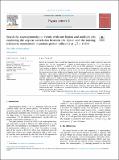Search for Supersymmetry in Events with One Lepton and Multiple Jets Exploiting the Angular Correlation Between the Lepton and the Missing Transverse Momentum in Proton–proton Collisions at √s = 13 TeV
Author(s)
CMS Collaboration; Abercrombie, Daniel Robert; Allen, Brandon Leigh; Azzolini, Virginia; Barbieri, Richard Alexander; Baty, Austin Alan; Bi, Ran; Brandt, Stephanie Akemi; Busza, Wit; Cali, Ivan Amos; D'Alfonso, Mariarosaria; Demiragli, Zeynep; Gomez-Ceballos, Guillelmo; Goncharov, Maxim; Hsu, Dylan George; Iiyama, Yutaro; Innocenti, Gian Michele; Klute, Markus; Kovalskyi, Dmytro; Lai, Yue Shi; Lee, Yen-Jie; Levin, Amy Elizabeth; Luckey Jr, P David; Maier, Benedikt; Marini, Andrea Carlo; McGinn, Christopher Francis; Mironov, Camelia Maria; Narayanan, Siddharth Madhavan; Niu, Xinmei; Paus, Christoph M. E.; Roland, Christof E; Roland, Gunther M; Salfeld-Nebgen, Jakob Maxillian Henry; Stephans, George S. F.; Tatar, Kaya; Velicanu, Dragos Alexandru; Wang, Jing; Wang, Ta-Wei; Wyslouch, Boleslaw; ... Show more Show less
Download1-s2.0-S037026931830217X-main.pdf (1.542Mb)
PUBLISHER_CC
Publisher with Creative Commons License
Creative Commons Attribution
Terms of use
Metadata
Show full item recordAbstract
Results are presented from a search for supersymmetry in events with a single electron or muon and hadronic jets. The data correspond to a sample of proton–proton collisions at s=13TeV with an integrated luminosity of 35.9fb⁻¹, recorded in 2016 by the CMS experiment. A number of exclusive search regions are defined according to the number of jets, the number of b -tagged jets, the scalar sum of the transverse momenta of the jets, and the scalar sum of the missing transverse momentum and the transverse momentum of the lepton. Standard model background events are reduced significantly by requiring a large azimuthal angle between the direction of the lepton and of the reconstructed W boson, computed under the hypothesis that all of the missing transverse momentum in the event arises from a neutrino produced in the leptonic decay of the W boson. The numbers of observed events are consistent with the expectations from standard model processes, and the results are used to set lower limits on supersymmetric particle masses in the context of two simplified models of gluino pair production. In the first model, where each gluino decays to a top quark–antiquark pair and a neutralino, gluino masses up to 1.8 TeV are excluded at the 95% CL. The second model considers a three-body decay to a light quark–antiquark pair and a chargino, which subsequently decays to a W boson and a neutralino. In this model, gluinos are excluded up to 1.9 TeV. Keywords: CMS; Physics; Supersymmetry
Date issued
2018-03Department
Massachusetts Institute of Technology. Department of Nuclear Science and Engineering; Massachusetts Institute of Technology. Department of Physics; Massachusetts Institute of Technology. Laboratory for Nuclear ScienceJournal
Physics Letters B
Publisher
Elsevier
Citation
Sirunyan, A.M. et al. “Search for Supersymmetry in Events with One Lepton and Multiple Jets Exploiting the Angular Correlation Between the Lepton and the Missing Transverse Momentum in Proton–proton Collisions at √s = 13 TeV.” Physics Letters B 780 (May 2018): 384–409 © 2018 The Authors
Version: Final published version
ISSN
0370-2693